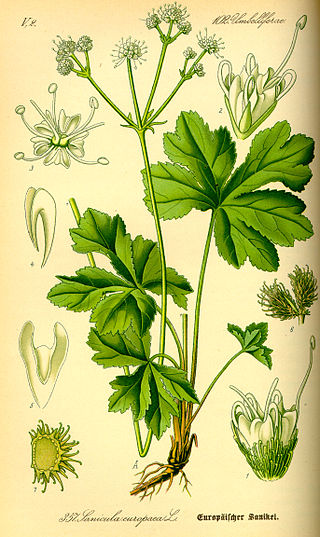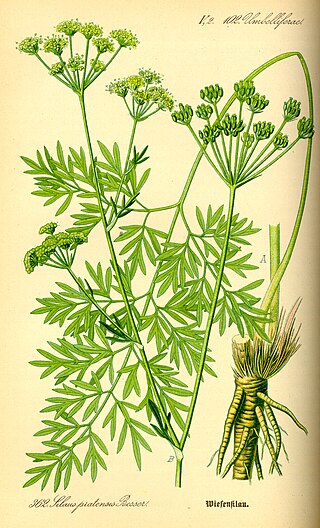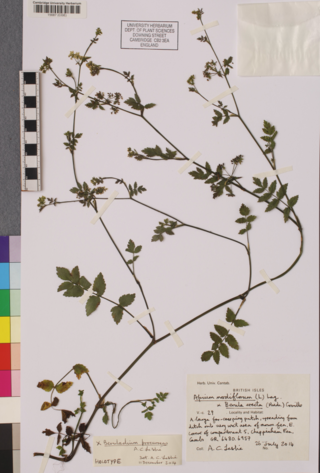
Apiaceae or Umbelliferae is a family of mostly aromatic flowering plants named after the type genus Apium and commonly known as the celery, carrot or parsley family, or simply as umbellifers. It is the 16th-largest family of flowering plants, with more than 3,800 species in about 446 genera, including such well-known and economically important plants as ajwain, angelica, anise, asafoetida, caraway, carrot, celery, chervil, coriander, cumin, dill, fennel, lovage, cow parsley, parsley, parsnip and sea holly, as well as silphium, a plant whose identity is unclear and which may be extinct.

Celery is a marshland plant in the family Apiaceae that has been cultivated as a vegetable since antiquity. Celery has a long fibrous stalk tapering into leaves. Depending on location and cultivar, either its stalks, leaves or hypocotyl are eaten and used in cooking. Celery seed powder is used as a spice.

Cyclospermum is a small genus of plants in the family Apiaceae. There are three species, including the well-known weed Cyclospermum leptophyllum, the marsh parsley or fir-leafed celery.
Sclerosciadium is a monotypic genus of flowering plant in the family Apiaceae. Its sole species is Sclerosciadium nodiflorum, native to Morocco and Western Sahara. The species was first described in 1800 as Oenanthe nodiflora.

Sanicula is a genus of plants in family Apiaceae, the same family to which the carrot and parsnip belong. This genus has about 45 species worldwide, with at least 22 in North America. The common names usually include the terms sanicle or black snakeroot.

Helosciadium bermejoi, synonym Apium bermejoi, is a critically endangered species of flowering plant in the family Apiaceae.

Cyclospermum leptophyllum is a species of plant in the family Apiaceae known by the common names marsh parsley, slender celery and fir-leaved celery. This is a plant found worldwide at warm temperate to tropical latitudes and is considered a noxious weed in many areas. It is a taprooted branching herb reaching just over half a meter in height at maximum. It has threadlike green leaves a few centimeters long and small umbels of spherical flowers.
Apium insulare, Flinders Island celery, or Island celery is a herb of the Bass Strait islands, and Lord Howe Island, Australia. It is a member of the Apiaceae (carrot family.
Apium virus Y (ApVY) is a plant pathogenic virus in the genus Potyvirus and the virus family Potyviridae.

Celery mosaic virus (CeMV) is a plant pathogenic virus in the genus Potyvirus and the virus family Potyviridae .

Papilio brevicauda, the short-tailed swallowtail, is a North American butterfly in the family Papilionidae.

Euleia heraclei, known as the celery fly or the hogweed picture-wing fly is a species of tephritid or fruit flies in the genus Euleia of the family Tephritidae.

Helosciadium nodiflorum, fool's watercress, is a flowering plant found in ditches or streams, as well as fresh and brackish-water wetlands native to western Europe. It is not poisonous to humans but it could be easily confused with the allegedly poisonous lesser water parsnip.

Apium annuum is one of the 20 species of the genus Apium of the family Apiaceae. It is an annual herb with a distribution in salt-marsh and saline habitats of Victoria, south and western Australia.

Silaum is a genus of flowering plants in the carrot/parsley family, Apiaceae. There are currently ten species placed into the genus, a list of which is provided below.

Helosciadium × longipedunculatum, synonym Apium × longipedunculatum, is a hybrid plant in the umbellifer family (Apiaceae); the result of hybridisation between Helosciadium repens and Helosciadium nodiflorum.

× Beruladium procurrens is an intergeneric hybrid plant in the umbellifer family (Apiaceae); the result of hybridisation between Berula erecta and Helosciadium nodiflorum.

Hladnikia is a monotypic genus of flowering plants belonging to the family Apiaceae. Its sole species, Hladnikia pastinacifolia, is a Slovenian paleoendemite, restricted to the area of only 4 km2, located in Trnovo Forest Plateau, karst plateau of Western Slovenia. German botanist Heinrich Gottlieb Ludwig Reichenbach named the genus after Carniolan botanist and founder of Ljubljana Botanical Garden Franz Hladnik.
Helosciadium is a genus of flowering plants belonging to the family Apiaceae.















